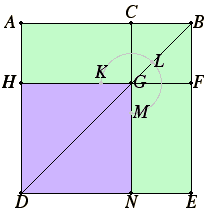Proposition 7
Let a straight line AB be cut at random at the point C.
I say that the sum of the squares on AB and BC equals twice the rectangle AB by BC plus the square on CA.

Describe the square ADEB on AB, and let the figure be drawn.
Then, since AG equals GE, add CF to each, therefore the whole AF equals the whole CE.
Therefore the sum of AF and CE is double AF.
But the sum of AF and CE equals the gnomon KLM plus the square CF, therefore the gnomon KLM plus the square CF is double AF.
But twice the rectangle AB by BC is also double AF, for BF equals BC, therefore the gnomon KLM plus the square CF equal twice the rectangle AB by BC.
Add DG, which is the square on AC, to each. Therefore the gnomon KLM plus the sum of the squares BG and GD equals twice the rectangle AB by BC plus the square on AC.
But the gnomon KLM plus the sum of the squares BG and GD equals the whole ADEB plus CF, which are squares described on AB and BC.
Therefore the sum of the squares on AB and BC equals twice the rectangle AB by BC plus the square on CA.
Therefore if a straight line is cut at random, then the sum of the square on the whole and that on one of the segments equals twice the rectangle contained by the whole and the said segment plus the square on the remaining segment.